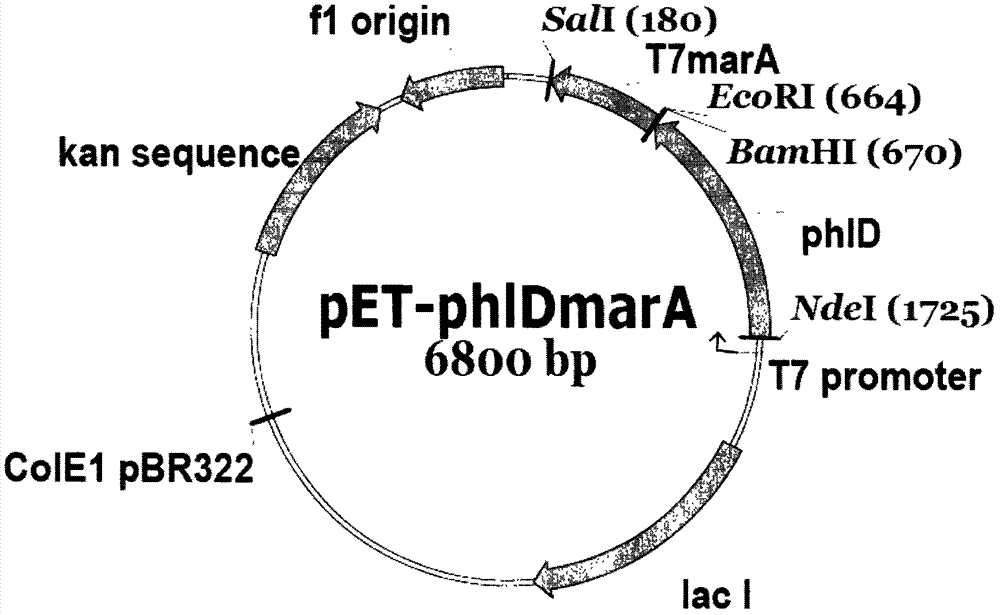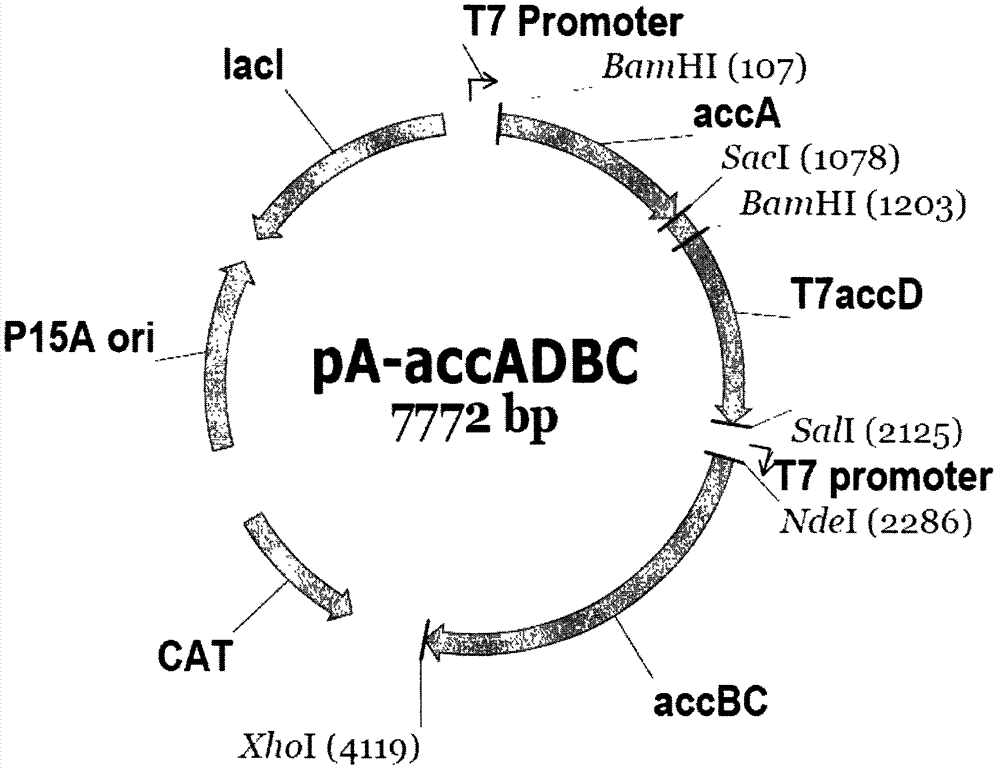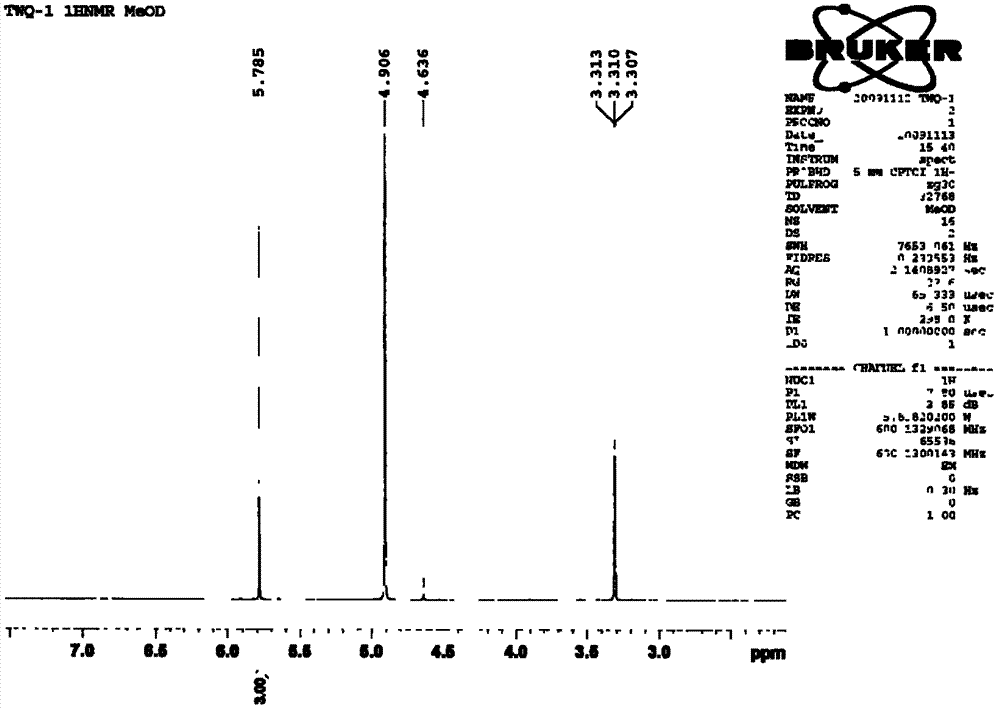Method for improving phloroglucinol synthetic capability of engineering escherichia coli
A technology of phloroglucinol and Escherichia coli, which is applied in the field of preparing phloroglucinol, can solve the problems of low yield, inappropriate synthesis of phloroglucinol and the like, and achieves the effect of improving synthesis capacity
- Summary
- Abstract
- Description
- Claims
- Application Information
AI Technical Summary
Problems solved by technology
Method used
Image
Examples
Embodiment 1
[0040] Construction of polyketene anhydride synthase (phlD) and multiple resistance factor (marA) co-expressed carrier, the specific process is as follows:
[0041] Using oligonucleotides 5'-CAT GCC ATG GTA GAT AAA CGC GAA TC-3' and 5'-ACG CGT CGA CTC AGAAGG CAG ACG TAT CC-3' as primers, Pseudomonas fluorescens Pf-5[Psendomonas fluorescens Pf-5 (purchased from the American Type Culture Collection, ATCC BAA-477)] genomic DNA was used as a template, and the polyketene anhydride synthase (phlD) gene was amplified by the polymerase chain reaction (PCR) method, and NdeI and BamHI sites were introduced at the 5' end and 3' end, respectively, and then the gene was cloned into the pET30a (Novagen) vector that was also digested with NdeI and BamHI using the above restriction sites to obtain the recombinant plasmid pET-phlD; Using oligonucleotides 5'-CAT GCC ATG GGC ATG TCC AGA CGC AAT ACT GAC GC-3' and 5'-GGA GGA TCC TAG CTG TTG TAA TGA TTT AAT GGA TG-3' as primers, Escherichia coli BL...
Embodiment 2
[0045] The recombinant plasmids pET-phlDmarA and pA-accADBC constructed in Example 1 were co-transformed into Escherichia coli BL21 (DE3) by the heat shock transformation method, and then spread on cells with two resistances to kanamycin and chloramphenicol. Positive clones were screened on LB solid medium plate to obtain recombinant Escherichia coli BL21 / phlDACCasemarA.
Embodiment 3
[0047] The recombinant Escherichia coli BL21 / phlDACCasemarA constructed in Example 2 is used to ferment and produce phloroglucinol, and the steps are as follows:
[0048] Inoculate the recombinant cells at an inoculum volume of 1% by volume to add 50 μg·mL -1 Kanamycin and 30 μg·mL -1 Ferment in the M9 fermentation medium of chloramphenicol, cultivate to OD under the conditions of culture temperature 30°C, stirring speed 400rpm, pH 6.0 and dissolved oxygen 18% or more 600 About 8, add the inducer IPTG to the final concentration of 0.1mmol L -1 , continue feeding 40% by weight of glucose to ferment for 12 hours;
[0049] The culture medium was centrifuged to separate the cells and the supernatant, and the supernatant was extracted once with an equal volume of ethyl acetate;
[0050] The combined extraction products were concentrated by distillation under reduced pressure, and the resulting solid powder was subjected to proton nuclear magnetic resonance spectrum (see attached...
PUM
 Login to View More
Login to View More Abstract
Description
Claims
Application Information
 Login to View More
Login to View More - R&D
- Intellectual Property
- Life Sciences
- Materials
- Tech Scout
- Unparalleled Data Quality
- Higher Quality Content
- 60% Fewer Hallucinations
Browse by: Latest US Patents, China's latest patents, Technical Efficacy Thesaurus, Application Domain, Technology Topic, Popular Technical Reports.
© 2025 PatSnap. All rights reserved.Legal|Privacy policy|Modern Slavery Act Transparency Statement|Sitemap|About US| Contact US: help@patsnap.com



